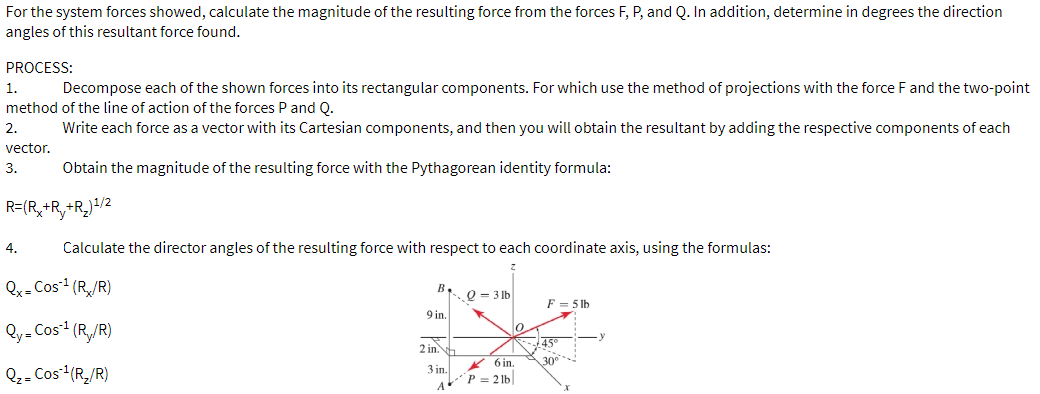For the system forces showed, calculate the magnitude of the resulting force from the forces F, P, and Q. In addition, determine in degrees the direction angles of this resultant force found. PROCESS: 1. Decompose each of the shown forces into its rectangular components. For which use the method of projections with the force F and the two-point method of the line of action of the forces P and Q. 2. Write each force as a vector with its Cartesian components, and then you will obtain the resultant by adding the respective components of each vector. 3. Obtain the magnitude of the resulting force with the Pythagorean identity formula: R=(R,+R,+R,)+/2 4. Calculate the director angles of the resulting force with respect to each coordinate axis, using the formulas: Qx- Cos (R/R) B. Q = 3 lb F = 5 lb 9 in. Qy= Cos (R,/R) 45 30 2 in. * 6 in. Q- Cos (R,/R) 3 in. P = 2 lb
For the system forces showed, calculate the magnitude of the resulting force from the forces F, P, and Q. In addition, determine in degrees the direction angles of this resultant force found. PROCESS: 1. Decompose each of the shown forces into its rectangular components. For which use the method of projections with the force F and the two-point method of the line of action of the forces P and Q. 2. Write each force as a vector with its Cartesian components, and then you will obtain the resultant by adding the respective components of each vector. 3. Obtain the magnitude of the resulting force with the Pythagorean identity formula: R=(R,+R,+R,)+/2 4. Calculate the director angles of the resulting force with respect to each coordinate axis, using the formulas: Qx- Cos (R/R) B. Q = 3 lb F = 5 lb 9 in. Qy= Cos (R,/R) 45 30 2 in. * 6 in. Q- Cos (R,/R) 3 in. P = 2 lb
International Edition---engineering Mechanics: Statics, 4th Edition
4th Edition
ISBN:9781305501607
Author:Andrew Pytel And Jaan Kiusalaas
Publisher:Andrew Pytel And Jaan Kiusalaas
Chapter1: Introduction To Statics
Section: Chapter Questions
Problem 1.38P: To move the oil drum, the resultant of the three forces shown must have a magnitude of 500 N....
Related questions
Question

Transcribed Image Text:For the system forces showed, calculate the magnitude of the resulting force from the forces F, P, and Q. In addition, determine in degrees the direction
angles of this resultant force found.
PROCESS:
1.
Decompose each of the shown forces into its rectangular components. For which use the method of projections with the force F and the two-point
method of the line of action of the forces P and Q.
2.
Write each force as a vector with its Cartesian components, and then you will obtain the resultant by adding the respective components of each
vector.
3.
Obtain the magnitude of the resulting force with the Pythagorean identity formula:
R=(R,+R,+R,)+/2
4.
Calculate the director angles of the resulting force with respect to each coordinate axis, using the formulas:
Qx- Cos (R/R)
B.
Q = 3 lb
F = 5 lb
9 in.
Qy= Cos (R,/R)
45
30
2 in.
* 6 in.
Q- Cos (R,/R)
3 in.
P = 2 lb
Expert Solution
This question has been solved!
Explore an expertly crafted, step-by-step solution for a thorough understanding of key concepts.
This is a popular solution!
Trending now
This is a popular solution!
Step by step
Solved in 3 steps with 3 images

Recommended textbooks for you

International Edition---engineering Mechanics: St…
Mechanical Engineering
ISBN:
9781305501607
Author:
Andrew Pytel And Jaan Kiusalaas
Publisher:
CENGAGE L

International Edition---engineering Mechanics: St…
Mechanical Engineering
ISBN:
9781305501607
Author:
Andrew Pytel And Jaan Kiusalaas
Publisher:
CENGAGE L